Once upon a time, hamburgers were the All-American inexpensive meals that Dad was allowed to immolate in the backyard until they looked, and tasted like, black hockey pucks. Then came McDonald’s and burgers became tan and tasted like a tanned hide.
To the observant burgologist, there are at least a dozen distinct species and subspecies of burger. Like sports teams, everyone has a favorite. Most hamburgers are distinguished mainly by the condiments. But condiments don’t make the burger. The meat does. And how you cook it.
To learn the burger-making secrets of the pros, read my article on The Science of Hamburgers, learn how to Grind Your Own Burgers, and check out my recipes for Steakhouse Steakburgers, and Diner Burgers.
But first, let’s play culinary anthropologist and study the menu of the major species of burger, the hamburger family tree. For the sake of argument, I will define a hamburger as a sandwich with a patty made mostly from ground beef, cooked, and served between halves of a bun or two pieces of bread that can be garnished with an infinite number of condiments.
If I’ve missed a legit style, let me know by adding it to the comments section at the bottom of the page.
Burger Styles 101
Steakhouse Steakburgers
This is the burger that wakes me up in the middle of the night. It is floating above my bed, just out of reach, dripping on my forehead and whispering provocatively, “Eeeeat me, eeeeat me.”
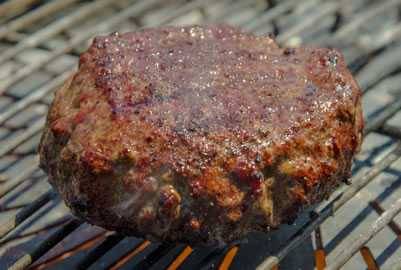
Made from ground steak, not scraps of lips and tail, it’s adipose at 8 ounces (227 ml) and 3/4″ (19mm) thick and goes bumper to bumper on a 4″ (10 cm) bun, with a chocolate brown crust whose savor is accented with charred beef fat amplified by more than a kiss of salinity, and, when broached, it bursts like a grape in my mouth, coating it with earthy beefy flavor that says “I am not a lowly peasant meal, I am not an assembly line product, I am a rare treat that is American cuisine at its epitome because to make me properly you’ve gotta have your stuff together.”
In its dominion, the steakhouse, this steakburger is usually broiled under scorching hot gas flames until the proteins metamorphose and the lipids in the fats char. It sits on a pillowy soft bun capable of absorbing its ample juices, buttered and toasted enough to add richness and crackly texture, simply adorned with lettuce, tomato, perhaps salty/smoky/crunchy bacon, maybe a viscous layer of melted cheddar, and your choice of ketchup, mustard, mayo, or a blend of all three. In such a state, it transmogrifies from a simple sandwich to feast. Forget everything you think you know about cooking burgers. Click here for my recipe for the perfect Steakhouse Steakburger.
Diner Burgers
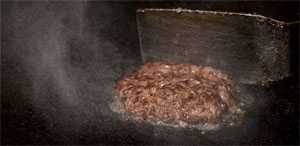
The Diner Burger and variations on the theme have a vocal following, with good reason. It is a 3 to 4-ounce (85-113 g) thin disk of ground beef slapped on a blistering hot griddle, cooked quickly until it is mahogany and crisp on one side, then flipped and seared until the second side matches the first. If the griddle is blazing hot this can happen before the center dries out. The griddle makes contact with maximum meat surface, and that is what the Diner Burger is really all about. Beefy flavor and two surfaces turned brown by that miracle of chemistry, the Maillard reaction that makes proteins soar beyond their natural state when heated well above 300°F (149°C).
SUBSPECIES: The smash burger. This is made by pressing the raw meat down hard onto the griddle with a trowel or heavy spatula. Sometimes the meat is rolled into a meatball before smashing. The smashing insures maximum contact with the griddle to maximize browning, and tends to produce jagged edges. The key is that the smashing is done on raw meat. If you smash meat while it is cooking you squeeze out juices.

SUBSPECIES: In-N-Out Animal Style. In-N-Out Burger opened in 1948 in Baldwin Park, CA, and has achieved cult status, partially for quality (INO controls the sources for much of its meat and other ingredients), partially for service, and partially for its not-so-secret menu of items not on the menu, and partially because it is available only at about 250 restaurants in California, Arizona, Nevada, Utah, no more than a day’s drive from their distribution center in Baldwin Park. The staff will prepare their patties just about any way you want, but several popular items should be considered true regional styles. Perhaps the most notable is the “Animal Style” which is slapped on the griddle and then smeared on top with Dijon-style mustard before flipping. Typical Animal Style also includes lettuce, tomato, four slices of American cheese, pickles, grilled onions, and extra spread (thousand island style), but you can customize it.
SUBSPECIES: The Onion Burger. An excellent variant of the Diner Burger is The Onion Burger, where raw onions are pressed into the raw top of the patty while the first side is on the griddle, and, when it is flipped, they caramelize and get sweet in the grease and practically fuse to the burger’s surface. Click here for my recipe for the perfect Diner Burger.
Cheeseburgers
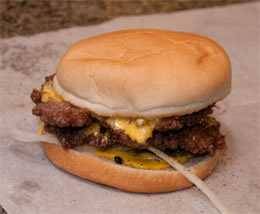
It’s really a stretch to call the cheeseburger a distinctive style of burger because, to make a cheeseburger, all you need to do is add cheese to any of the other burger species. Technically, the cheese is a condiment, or a topping, even though sometimes the cheese is placed between two thin patties to make the ever-popular subspecies called the Double Cheeseburger or The Big Baby on Chicago’s Southside. Click here for my article on The Science of Cheeseburgers.
SUBSPECIES: Pizza Burgers. Top the burger with pizza sauce, which is often just tomato sauce with some oregano added, and melt mozzarella on top. Amp it up with mushrooms and onions if you wish. Despite its national popularity, I consider this just a variation of the cheeseburger.
SUBSPECIES: The Pimento Cheese Burger (shown at the top of the page). The Pimento Cheese Burger is especially popular in Columbia, SC, and other pockets of the South. Pimento cheese spread replaces the melted cheese as well as the ketchup, mustard, and secret sauces. You can add lettuce, tomato, and onion, but that’s it, and that’s unnecessary. And yes, I know the correct spelling is pimiento with two “i”s, but nobody spells it that way. And yes, I know cheeseburger is one word in most places, but in the South, it is often two words. The Varsity, in Atlanta, GA, probably sells more Pimento Cheese Burgers than anyone else, maybe even more than everyone else combined. The one pictured at the top of the page, from 17th Street Bar & Grill in Murphysboro, IL, is my favorite. It’s a fine-tasting 8-ounce burger, nicely flame-grilled, with a creative spicy pimento cheese topping. There’s also a 4-ounce version. Neither is on the menu, so ask for it.
Patty Melt
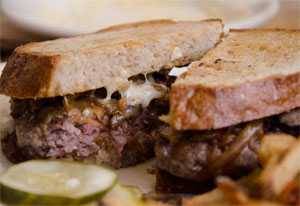
The Patty Melt is a cross between the Cheeseburger and the grilled cheese sandwich. Traditionally, it is a pan or griddle-seared hamburger patty topped with pan-fried onions topped with Swiss Cheese, then placed between slices of rye bread, cooked on both sides in butter until the bread is toasted and the cheese has melted. Variations include white bread, sourdough, ciabatta, and cooking on a panini sandwich press. The one below is the superb traditional version served at Zingerman’s Roadhouse in Ann Arbor, MI. It is griddle seared, with caramelized onions, wild mushrooms, a first-rate Swiss, and house-baked rye with a killer crust. Get the sweet potato fries and the pimento cheese macaroni.
Store Burgers

In my private lexicon, Store Burgers are dispensed by the national fast food chain “stores” as their owners prefer to call them, rather than restaurants. The skimpy patties are made in a warehouse far far away, using trimmings of inferior cuts of meat and slabs of fat, pressed in a mold so they are perfectly flat and round, frozen, and shipped across state lines in giant reefer (refrigerator) semi-trailer trucks. Sadly, burgers are not covered by the Mann Act. Some places griddle them, some flame broil them, but, if you peel off the smushed bun, wilted lettuce, pink tomato, corrugated pickle slices, and not-so-special sauce, you find uniformly gray flaps of mystery meat ground so fine that no bone could survive. They are all cooked well past well done until they are dry and closer to a chamois than a happy meal, wrapped in toilet paper, held under heat lamps until the buns are limp and soggy, and served in a cardboard casket. RIP.
Homestyle Burgers
These are the burgers Grandma made. Big and fat and loaded on the inside with so many veggies that they almost qualify as a well-rounded meal. Grandma loved to chop up onions, garlic, green peppers, and a splash of steak sauce or Worcestershire sauce. Maybe she’d even mix in some breadcrumbs and an egg as binders. More like meatloaf on a bun, she’d cook these in a frying pan on the stovetop, or even in the oven. Because of all the moisture, they were juicy and crumbly. When you were 10, nothing tasted better after a snowball fight. Now they taste like nothing less than home sweet home.
Jucy Lucy (Also Known as the Juicy Lucy) and other Stuffed Burgers
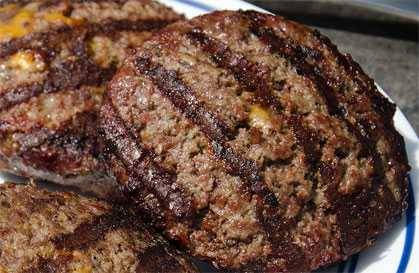
The Chicago Tribune restaurant critic Louisa Chu says “The Jucy Lucy may be the best burger in America” and “an ideal convergence of beef and cheese.”
Take a thin patty, fold a slice of American cheese twice, and then top it all with another patty. Pinch the edges together thoroughly and tightly to seal in the goodness and so it won’t leak. That’s your Jucy Lucy, so named in 1954 by Matt’s in Minneapolis, MN, and that’s right, there’s no “i” in Jucy.
The molten core of the Jucy Lucy is really really hot, so let it cool a bit before your first bite, or slice it in half. You can try using Swiss, blue, herbed cream cheese, or you can use butter, especially herbed butter, or sautéed mushrooms, caramelized onions, bacon jam, jalapeños, you name it. But those are Stuffed Burgers, not Jucy Lucys. There’s even a gizmo out now that helps you make stuffed burgers called Stufz. It works pretty well.
Steamed Burgers
SUBSPECIES: Slyders. These burgers are cooked with steam rather than dry heat. White Castle “Slyders” (a.k.a. Sliders) are the most famous steamed burgers, so named because they slide right down. And yes, they were originally trademarked with a “y”. That’s one below.

First, a layer of chopped onion bits that have been defanged by soaking in water go on a medium hot griddle, then the 2.5″ (63 mm) square patties go on top of them, never touching the griddle, each with five holes punched in them to speed cooking and to distribute the onion flavor. Then some salt is sprinkled on the squares, then one lonesome crinkle-cut dill pickle slice goes over the center hole, then the bun bottoms, face down, then the bun tops are squeezed into gaps between the bottoms. They sit there and steam in the mist from the onions and the meat, without a cover, just the buns on top. No flipping is necessary. When the order comes in the cook slips the patty and the onions beneath it onto a bun bottom, more cooked onions go on top, your choice of ketchup or mustard, then the top. Take home a sack.
SUBSPECIES: The Connecticut Steamed Cheeseburger
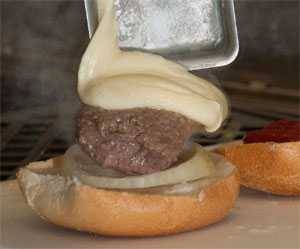
Now these are not the same concept as other steamed burgers like the White Castle Slider, which are griddled on one side and steamed on the top. Just cram a 1/3 pound (151 g) patty into a rectangular aluminum pan about 2″ x 3″ (51-76 mm), put a 2 ounce (57 g) hunk of cheese in another pan, and slip them into a small stainless steel steamer box. The Burg’r Tend’r is similar to the one used at Ted’s. No need to flip it. In about 12 minutes you have a well-done, wet, rectangular burger topped with gooey cheddar.
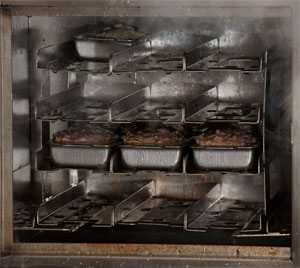
Probably the best-known practitioner is Ted’s World Famous Restaurant in Meriden, just south of Hartford, founded in 1959. A tiny hole in the wall, it is now run by Bill Foreman, a nephew of the founder, Ted Duberek. Each burger is made to order from fresh twice ground beef, and there are often lines to get in. Make sure you order the home fries.
SUBSPECIES: Dome Burgers. This variant of the Steamed Burger can be found in scores of diners across the nation. The Diner Burger patty is cooked on a griddle under a metal dome, combining dry heat from below, and steam from above. Some short-order cooks even sprinkle water or shaved ice under the dome to create more steam.
Deep Fried Burgers
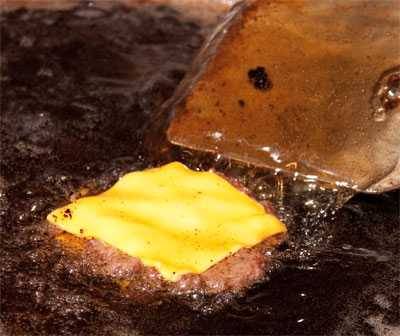
Load up a frying pan with oil, preferably tallow made by rendering beef fat, make a thin patty, and when the oil is burbling, in goes the meat. It will sink, and when the crispy disk floats to the top, it is done. Shake off the surface oil, and onto the bun it goes.
Since 1912, Dyer’s Burgers on Beale St. in Memphis has been the mecca for deep-fried burger lovers. Dyer’s even makes a cheeseburger by putting a slice of cheese on top of the patty as it floats in the grease and the cook scoops hot oil over the top, as shown at right. Playboy ranks it as one of the nation’s top 10, and Esquire puts it on their list of “60 Things Worth Shortening Your Life For.” The owner says his secret is “Pride, tradition, and grease.”
Several places also batter and fry their patties, among them Sumo Grub in Berkeley, CA, where they encase their meat in a panko-based crust. In Jefferson City, MO, Paddy Malone’s Yogi Burger is a half-pound patty that is dipped in batter and then deep fried, topped with Thousand Island Dressing and all the fixins’ and served on Texas Toast. Is that Irish?
Butterburgers

Popular in the dairy state of Wisconsin, there are several variations on the Butter Burger. Some schmear the patty with butter before griddling, some schmear the bun before griddling, but the original, Solly’s Grille, next door to a heart hospital in Milwaukee, does it simply by slathering butter from Fries Von Keil generously on the toasted bun before enveloping the sirloin patty with the lipid-laden bread.
At Solly’s you should most definitely order the chopped onions which are simmered in butter on the griddle. The concept may sound a bit like overkill, but it is very tasty and nobody ever complains that they are dry. In the picture above, you can see the butter-soaked bottom of the bun and the chopped onions griddled in scads of butter oozing over the top. Make sure you have a Sprecher’s Root Beer with your Butter Burger.
Ironically, the ButterBurger at Culver’s, a national chain, is not a true butter burger. It gets its name from a small amount of butter on the toasted bun, something any good burger should have. I go to Culver’s for the custards, not the burgers.
Smoked Burgers
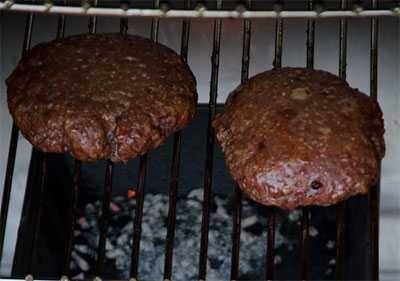
Put your patties in a smoker and then take them out and brown them in a frying pan or on a griddle. Surprisingly, only a few barbecue joints around the nation do it. Among the best is Guy’s Market in Houston. The best BBQ man in the state, Robb Walsh, says to get it with BBQ sauce, onions and pickles, not lettuce and tomato. The Original Texas Barbecue King in LA smokes their humongous one-pound King burgers on their smoker beneath their ribs so they can catch the drippings. That’s what I’m talkin’ ’bout! I put it in my smoker at about 225°F (107°C) with lots of smoke for about 15 minutes, and then pan-sear it on top of the grill.
Veggie/Plant-based Burgers
Not to be left out of the burger party, non-meat eaters have long had their own vegetable/plant-based patty options. Dating back to 1979, Boca was one of the first brands of frozen vegetarian burger patties with its “Sun Burger.” Since then, countless other brands like GardenBurger and Morning Star Farms have followed suit but it wasn’t until Beyond Meat, Inc. introduced the Beyond Burger in 2016 that plant-based burgers actually looked, cooked, and (kind of) tasted like animal meat.
The Novelty Burger
Finally, we have the Novelty Burger. One might be charitable and call them creative burgers made by innovative chefs, but most don’t deserve such elevation.
SUBSPECIES: Silly Burgers. Every pub looking to differentiate itself from the beer hall across the street feels the need to tweak the formula beyond the rational. They come with all manner of mix-ins, ranging from the insanely hot Bhut jolokia (a.k.a. the “Indian ghost chile”) to hard-boiled eggs. Another Silly Burger, perhaps the silliest of them all, is the Luther Burger, named after one of its early fans, singer/songwriter Luther Vandross. It is a patty between two donuts or donut halves. It was relatively unknown until it starred in a TV cartoon, and grew in fame when the Gateway Grizzlies, a minor league baseball team in St. Louis, started serving it. To make it, they split a deep-fried Krispy Kreme donut, lay a patty on it, and top it with bacon and melted cheese. Is there a doctor in the stadium?
We can also include in this category the 50-pound burgers (betcha can’t eat one), the quadruple stack (held together by skewers, not toothpicks), and the burgers topped with everything from pineapple rings to salmon. Any attempt to list all the Silly Burgers is as futile as trying to list all political lies.
SUBSPECIES: Mini-Burgers. Among the subspecies is the recent trend of mini burgers. Some are thin disks, some are fat, they are meant to be less filling and higher in markup, and are often served with chocolate martinis and other abominations in shee-shee bars. Some audacious and uneducated chefs call them sliders. Not, not, not!

SUBSPECIES: Gourmet Burgers. A subspecies of the Silly Burger is the Gourmet Burger. The concept goes back to the original Hamburg steak and its descendant, the Salisbury Steak (see below), which is an attempt to make ground beef compete with real steaks. The concept of upscale hamburgers died as buns swallowed ground meat like Pacman, then resurfaced in 1975, when Manhattan’s fabled “21” Club served a $21 burger. Now Gourmet Burgers are everywhere. Scores of restaurants serve burgers made from expensive Kobe or Wagyu beef with exotic mix-ins and toppings. The New York Times credits (blames?) Daniel Boulud with starting the trend in 2001 at his former Times Square DB Bistro Moderne, when he stuffed ground sirloin with braised short ribs, foie gras, and truffles. At more than $30, it’s a fine sandwich, a little rare for my tastes, with a lump of foie gras about the size of a marble embedded in the center. That’s it at right.
In 2008 TV chef and restaurateur Bobby Flay opened Bobby’s Burger Palace in a New York City suburb, and other celebrity chefs have jumped on the bandwagon. Emeril Lagasse has opened BAM (Burgers And More) in the Sands Casino Resort in Bethlehem, PA. Hubert Keller has the Burger Bar in Las Vegas, St. Louis, and San Francisco. And, mon dieu, according to the New York Times, burgers are chic in Paris now!
Regional Hamburger Styles
Unlike hot dogs, which have numerous regional styles (see my article Hot Dog Road Trip), there are only a handful of hamburger styles that are truly regional. Many variations are served nationwide or limited to one restaurant. But there are a few styles that seem to have taken hold in a region where the locals call it their own. If you know of other regional styles, please let me know.
The New Mexico Green Chile Cheeseburger

The Green Chile Cheeseburger is the bomb in the Southwest, especially New Mexico. It is a cheeseburger crowned with green chiles or a green chile salsa. Sometimes the chiles are mild, sometimes medium, sometimes hot, and sometimes a blend. In some restaurants the chiles are smoke-roasted and peeled, some fry them on the griddle, and some puree them in a blender with other goodies. Some burgers are topped with bacon and a dollop of sour cream. My recipe was inspired by Bobby Olguin at the legendary Buckhorn Tavern in San Antonio, NM, established in 1943. If you’re down that way, don’t miss Owl Bar & Café, a short walk from Manny’s in San Antonio. Click here for my recipe for Encanto New Mexico Green Chile Cheeseburgers.
Oklahoma Onion Burgers
During the Depression meat was expensive so, legend has it, Ross Davis of the Hamburger Inn on Route 66 in El Reno decided to, ahem, beef up the burger by loading it up with onions. He took about half an onion, sliced it thin, tossed it on the hot griddle, and pressed the patty down on top. The original Hamburger Inn has closed, but a second location that opened in about 1938 is still going strong in Ardmore. But their style caught on and numerous restaurants around the state still serve onion burgers, most notably Tucker’s, a small chain. While the original was and the current classic version is a thin patty, The Mother Tucker weighs in at about a pound.
Oklahoma Theta Burgers
The Theta Burger can be found all over Oklahoma, and it is usually a 6-ounce patty topped with a smoky tomato sauce sometimes called “hickory sauce”, mayo, dill pickle slices, and shredded cheddar cheese, typically accompanied by onion rings and Dr. Pepper. Also called the Hickory Burger or the Barbecue Cheeseburger, they can occasionally be found in Texas.
Legend has it that the Theta Burger was invented at the Town Tavern in Norman, on the edge of the University of Oklahoma campus, in the ’30s or ’40s. Apparently, the Kappa Alpha Theta sorority (known as the Thetas) often called the tavern after curfew with a large complicated order for delivery. Owner Ralph Geist loved the business but hated that they tied up the phone and kitchen during a busy time. One of the orders may have been the combo that became the Theta Burger, or it may have been invented by Geist and/or his cook. Regardless, they named the concoction after the sorority so they would all order the same thing and make life easier. The taste was a hit and “I Ate A Theta” was a running joke on campus. It Shoulda been a bumper sticker.
In 1953, Vince Stephens, who may have worked for Geist, opened the Split-T restaurant 20 miles up the road to Oklahoma City. It was named after the backfield formation favored by the OU’s legendary coach Bud Wilkinson (three running backs in a row behind the QB, and one receiver split out wide). The Theta Burger was a hit in OKC, especially among the alums. Before long it had spread across the state.
The Town Tavern and the Split-T are long gone, but *Johnnie’s Charcoal Broiler in OKC is now the home of the most famous Theta Burger (founded by a Split-T alum). When the Split-T was sold in 1994, the recipes went to the new owner, and even though the restaurant was closed a few years later, the owners are selling Original Split-T Theta Hickory Sauce in local stores. It is very thick and tomatoey, much more like ketchup than the standard red barbecue sauce.
The Little Havana Frita
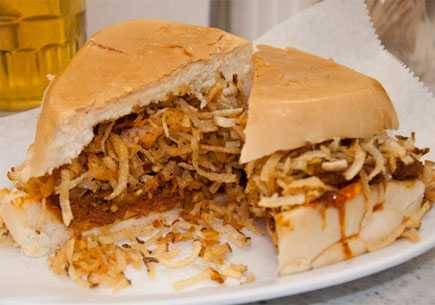
An import from Cuba, the frita is popular in Miami’s Little Havana along Calle Ocho (8th Street). The beef patty is thin, about 4 ounces, occasionally mixed with chorizo (a spicy, paprika-colored, coarsely ground pork sausage), slathered with a Picante sauce while it cooks, and topped with a mound of potato shards made by shredding potato on a box grater, then deep frying and salting them.
El Rey de las Fritas (The King of Fritas), is a spotless, friendly place in a strip mall on Calle Ocho, and it lives up to its moniker. No lesser a luminary than Bobby Flay calls their fritas the best burgers in Florida. He likes them so much that he imitates them with “crunchified” burgers at his restaurants, topped with crushed potato chips.
The San Antonio Beanburger
The San Antonio Beanburger is believed to have originated at the late and lamented Sill’s Snack Shack (a.k.a. The Triple S) in 1953. The patty is topped with refried pinto beans, cheese (usually Cheez Wiz or cheddar), onions, and crushed Fritos corn chips. Picante and guacamole occasionally barge in but they are interlopers. Several restaurants in and around San Antonio serve a version of the dish. One popular example is at Cheesy Jane’s.
The West Virginia Slaw Burger
The West Virginia Slaw Burger is made like their hot dogs, topped with ground beef chili, hashed coleslaw, chopped onions, and mustard. Click here for my recipe for the slaw.
The Cincinnati Chili Cheeseburger
This town has made its fast-food reputation with hot dogs (called Coneys) and spaghetti topped with a ground beef sauce called Cincinnati Chili, which is then topped with oyster crackers, a mound of shredded cheddar cheese, and onions. Although the Chili Cheeseburger is not widespread, it can be found at such landmarks as Gold Star Chili, and it earns status on this list because of the ubiquity of Cincinnati Chile on everything in that town. Click here for my recipe for Cincinnati Chili which you can add to your burgers with cheese and onions to approximate the real thing.
The LA Chili Burger
This is a burger topped with ground beef chili, sometimes served on a bun, sometimes open faced. Although it can be found around the nation, it seems to be popular in LA, especially since Tommy’s, a chain of more than 30 stores, specializes in it.
The New Orleans Burger Po’ Boy
New Orleans is famous for it po’ boy sandwiches, the local version of the submarine. A full po’ boy begins with a 12″ (30 cm) section cut from a long stick of flaky crust, soft center “French” bread and is usually filled with fried fish, fried shrimp, fried crab cakes, or andouille sausage or all of the above. Get a “po’ boy dressed” with lettuce or cabbage, tomatoes, pickles, mayo, and your choice of plain yellow mustard or spicy Creole mustard. Hot sauce is optional, but if you skip it they know you’re a tourist. Many places also sell po’ boy burgers. A shorty is a 6″ (15 cm) po’ boy. This is an interesting concept, and the po’ boy is clearly one of the nation’s great sandwiches, but the Po’ boy burger is really just a burger on po’ boy bread.
Michigan Olive Burger
Hard to call this a type of burger because it is simply a popular regional topping, but since it is regional, here ya go: Top a griddle patty with a mix of mayonnaise and chopped green olives, pimento optional. According to TasteAtlas.com “Some like to add a bit olive brine to the olive-mayo mix, while others put the mayonnaise on a bun, and the patties are topped with olives before they’re placed into the buns. There are many theories about the origins of this burger, and some people claim that Olympic Broil in Lansing made the first olive burger in the 1960s, while others say it was made much earlier at Kewpee Hotel Hamburgs in Grand Rapids.”
Burgers of other countries
Love of American culture has brought the hamburger to many countries where the growing demand was met by the expansion overseas of Mcdonald’s and Burger King. Some nations have their own peculiar twist on the concept.
Australia
In Australia a typical burger might have sweet canned beets (yuuuuuck), sunny-side up egg, and sliced or canned pineapple. It might also have chile paste such as sambal oelek or sriracha, bacon, cheese, lettuce, tomato, and onion. I am told that there might also be ketchup or barbecue sauce and that the challenge is to keep the beet juice off your shirt.
Dominican Republic Chimi Burgers
In the Dominican Republic, you can get Chimichurris, a.k.a. Chimi Burgers, from pushcarts and hole-in-the-wall joints everywhere. Each stand takes liberties with the recipe: Some use a green herb sauce similar to Argentine chimichurri sauce, while others mix in chopped onion, red bell pepper, garlic, oregano, and cilantro with the ground meat. They are served with a warm coleslaw on top, and a sauce made with ketchup, mayo, and mustard, similar to my Burger Glop recipe. Chimi Burgers have traveled with Dominican ex-pats to their new homes in New York and elsewhere.
India
In India, burgers are served on the flat traditional local Naan bread. Where beef is forbidden it is a veggie burger.
Irish Spice Burgers and Wurly Burgers
In Ireland, deep fried Spice Burgers are the rage. The original recipe had ground beef, onions, grains, spices, and coated with bread crumbs was invented by Walsh Family Foods in the 1950s. They are found mostly at “chippers”, restaurants specializing in fried fish and chips (potatoes). In Dublin Wurly Burgers are common, a pure beef burger dipped in batter and fried.
Korea
In Korea, don’t be surprised to find kimchi, a form of pickled cabbage, on your burger. Hey, just think of it as a type of kraut or slaw.
Malaysia
The Ramly burger is certainly one of the strangest in the world. Named after the company that makes the meat at the center of the concoction, ground beef, soy protein, spices, salt, as well as “flavouring, colouring, and permitted food conditioner.” A Ramly burger starts by cooking a patty on a griddle. Then an egg is broken and spread out on the griddle making a thin omelet. Before it solidifies the burger is placed in the center and the omelet, topped with a scoop of margarine, a splash of Worcestershire sauce, and another of Maggi seasoning (a soy based liquid flavor enhancer). Then the egg is folded around it and topped with ketchup, lettuce, and cheese, and served on a standard hamburger bun.
Serbia
The Balkan burger combines ground beef, pork and lamb, slapped into relatively thin patties, and grilled, broiled, or pan-fried. Called pljeskavica, Balkan burgers are often served in pita-like lepinja bread with condiments like kajmak, a cousin of clotted cream, and ajvar, a roasted red pepper and eggplant relish. The meat is variously seasoned, but onion, garlic, paprika, and black pepper are the most common additions.
Not Quite Burgers, But Close
Salisbury Steaks
In the 1860s, during the Civil War, Dr. James Henry Salisbury, had success treating diarrhea with a diet of all lean ground beef. In the 1880s he introduced the Salisbury Steak: Patties of beef scraped from pounded steaks, seasoned and mixed with onion, then grilled. He prescribed these three times a day as a treatment for all manner of digestive ailments. Within a few decades Salisbury Steaks began showing up on menus and in cookbooks, and can still be found on menus, particularly in rural areas, where they are often served on toast, smothered in gravy and mushrooms.
Hawaiian Loco Moco
Not a true hamburger because it is not served on a bun, this popular local specialty begins with a bed of white rice, which is topped with a ground beef patty or two, doused with brown gravy, and then crowned with a fried egg or two.
Meatball Sandwiches
An Italian American favorite. The meatballs are made with moistened bread, egg, and might even have pork or veal in the grind. Two or three balls, about 1.5 to 2″ (38-51 mm) are served on a section of a medium crust loaf with a soft center, topped with a marinara sauce, and often sautéd peppers and melted mozzarella cheese.
Meatloaf Sandwiches
These are usually made from leftover slices of meatloaf served on white bread, topped with ketchup.
Spoonburgers, Scoopburgers, Loose Meat Sandwiches, and Maid-Rites
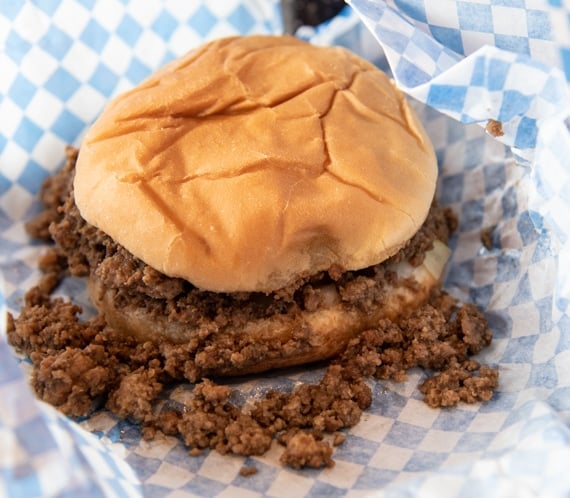
These are a mound of loose ground meat that has not been formed into a patty. Sometimes the meat is griddled and sometimes it is cooked in a pot with stock and spices. The meat is then piled on the bun, crumbly. Taylor’s Maid-Rite in Marshalltown, IA, has been making them since 1928 and they seem to be popular in many joints around the Mississippi River in Iowa and Illinois. That’s a Maid-Rite in the photo above. Here’s a video by Alton Brown when he visited a Main-Rite in Quincy, IL. But this is not a patty so it’s not really a burger. And I was unimpressed.
Sloppy Joes
A variation on the Spoonburger, this loose meat sandwich is usually ground beef cooked in a pan with onion and seasonings, drained, and mixed with a ketchup based sauce, usually doctored heavily and heartily.
Runzas
A German or Russian transplant to Nebraska, Iowa, Kansas, and Colorado, Runzas are soft buns, about 6 by 3″ (76 mm), stuffed with pockets of browned ground beef, cabbage, and onion, baked and served hot, sometimes topped with cheese. The dish even spawned a chain of Runza Hut restaurants based in Lincoln, NB, founded in 1949.
Doughburgers or Slugburgers
These are a holdover from The Depression when restaurants stretched ground meat by mixing it with flour and cooking it on a griddle. Sometimes called Slugburgers because you could buy one for a nickel (which was called a “slug” at the time), and they are still available in a handful of restaurants in the deep South. There are variations made with grits, soy meal, bread, potatoes, and crackers. There is even an annual Slugburger Festival in July in Corinth, MS, but if you miss the party, stop in at Borroum’s Drug Store & Soda Fountain in Corinth and order one. I’m told it hasn’t changed much since it was founded in 1865.
The Tastiest Burger Books
Hamburgers & Fries: An American Story by John T. Edge

Culinary historian, John T. Edge is a fun read. This book follows him cross country as he seeks regional styles and historical techniques that will help him unravel the story of the All-American hamburger. Here he describes his encounter with Jucy Lucy at Matt’s in Minneapolis, MN: “The burger at bottom right begins to wobble, ballooning outward and then quaking like a capsized turtle. Remember Alien? It’s not unlike that. If you missed Sigourney Weaver’s money shot, I’ll be more precise: it’s as if something is trapped inside that burger; it’s as if something wants out.
“Finally a minor geyser erupts, a thin stream of cheese spouting upward in a textbook exhibition of fluid dynamics. I hear a treble-register swish, an exhalation. And I watch as a blob of cheese exits the side of the burger… I learn from a woman two stools down that I have just witnessed what Jucy Lucy cultists know as a blowout.”
Hamburger: A Global History by Andy Smith

Culinary historian Andy Smith is a thorough researcher. I once attended a seminar he did on researching cultural history through food and was blown away by his thoroughness and the tricks of his trade. This definitive little book unwraps the mystery of the origin of the hamburger and its name, and traces its spread across the globe. The stories of White Castle, McDonald’s, and other chains and Mom & Pop burger stands is worth the modest price of admission. He debunks the myths that the Tartars invented hamburgers, that they first appeared on a menu at Delmonico’s in NYC in 1834, that Ray Kroc founded McDonald’s, and that the first Mickey D’s is in Desplaines, IL. All untrue.
Hamburger America: One Man’s Cross-Country Odyssey to Find the Best Burgers in the Nation [Book & DVD] by George Motz

George Motz has traveled the four corners of the nation to find the best and most interesting burger joints. Many are cultural and community icons, and Motz interviews the owners, writes about their burgers, and photographs the places beautifully.
The Tastiest Burger Websites
The best burger site by far is A Hamburger Today (AHT). It is gently patted together by Robyn Lee, is made of prime restaurant commentary, stuffed with burger lore, topped with good humor, and held together with beautiful drippy photographs. She is aided by a handful of burgerphiles who know their stuff, most prominently J. Kenji Lopez-Alt of Cooks Illustrated, whose “Burger Lab” is a testimony to the value of an MIT education. Read his article on salting ground meat.
GeorgeMotz.com and the Hamburger America Blog are where you will find George Motz, the talented writer and photographer whose book, Hamburger America is a must for any traveling burger lover. Click here for my review of this and other burger books.
The Burger Beast. Sef Gonzalez is a real burger fanatic, and it seems that is all he eats.
The Burger Voice. Still not sure who writes this fun blog out of Utah.

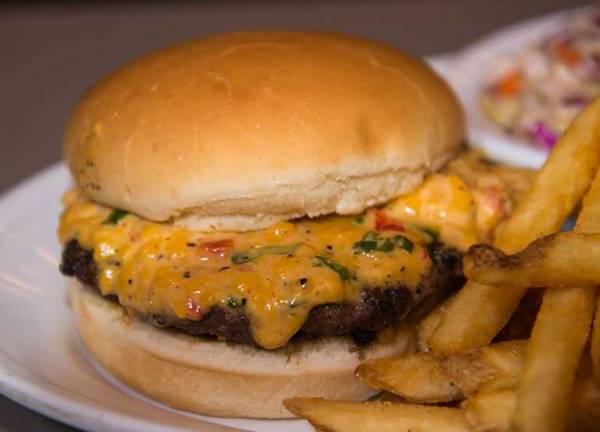

High quality websites are expensive to run. If you help us, we’ll pay you back bigtime with an ad-free experience and a lot of freebies!
Millions come to AmazingRibs.com every month for high quality tested recipes, tips on technique, science, mythbusting, product reviews, and inspiration. But it is expensive to run a website with more than 2,000 pages and we don’t have a big corporate partner to subsidize us.
Our most important source of sustenance is people who join our Pitmaster Club. But please don’t think of it as a donation. Members get MANY great benefits. We block all third-party ads, we give members free ebooks, magazines, interviews, webinars, more recipes, a monthly sweepstakes with prizes worth up to $2,000, discounts on products, and best of all a community of like-minded cooks free of flame wars. Click below to see all the benefits, take a free 30 day trial, and help keep this site alive.
Post comments and questions below
1) Please try the search box at the top of every page before you ask for help.
2) Try to post your question to the appropriate page.
3) Tell us everything we need to know to help such as the type of cooker and thermometer. Dial thermometers are often off by as much as 50°F so if you are not using a good digital thermometer we probably can’t help you with time and temp questions. Please read this article about thermometers.
4) If you are a member of the Pitmaster Club, your comments login is probably different.
5) Posts with links in them may not appear immediately.
Moderators